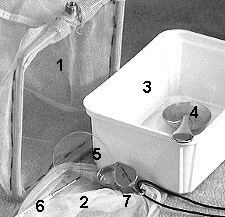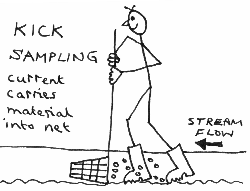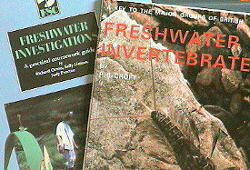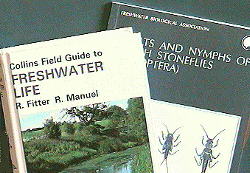STREAM DIPPING
by David Walker, UK
Regular readers of Micscape will
know that we are very enthusiastic about pond dipping as there is so much
of interest to look at both on the macro and micro scale. However, although
stream dipping can be just as rewarding, we've hardly mentioned it to date,
so here's a few thoughts on how to get started based on the author's own
experiences.
There are many aspects of stream sampling depending on whether it's just for fun or a part of an interesting amateur project, so this is very much a flavour with some books and courses mentioned if you would like to learn more.
Looking for the right habitat What 's the appeal of stream dipping Equipment - nothing expensive is needed Techniques - a new use for wellington boots Aspects of stream life to study Learning more - books and courses Disclaimer - please take care!
Looking for the right habitat
I couldn't find an adequate definition
of a stream so I'll leave it up to the reader to distinguish the smaller,
narrower and shallower stream from the more dangerous to sample canal or
river. In my area where there are hills up to 500m high there are many
small clean streams typically 0.5 to 2 metres across and less than 0.5m
deep with usually a steady flow of water (unlike drainage ditches). These
type of clean upland (or lowland) streams are usually safe to sample and
study if away from industrial areas or sewage and farm outfalls etc. Larger
streams and rivers can be safe to sample if there are wide shallow
areas with a firm flat bottom without a strong current, but obviously you
must use your discretion. If a youngster is reading this please do not
sample any water bodies without adult supervision, but adults should take
care as well!
What's
the appeal of stream dipping
Stream dipping is particularly likely
to appeal to the amateur microscopist and naturalist who has an interest
in macroscopic aquatic creatures. There are plenty of microscopic organisms
of interest as well, such as diatoms and other algae encrusted on stones
and living in mosses, but to the author at least, it is the marvellous
creatures specially adapted to flowing water that appeal most. The larvae
of mayflies, stoneflies and caddis flies for example are fascinating and
many have different ways of adapting to the stream flow depending on where
they live. Flatworms, molluscs, worms and Crustacea such as freshwater
shrimp may also be found.
These creatures can be easily admired at the stream side by eye and with a 10X hand lens when put in a shallow tray or dish, and if you have a small stereo microscope they can also be studied by the stream-side under incident light. This can reveal wonderful detail such as the plate-like or feather-like gills found on some insect larvae. If you are an adult with kids, they'll love standing (with supervision) in a small shallow stream in their wellingtons looking under stones and in the gravel to see where different types of organism live and how they adapt to living there.
Equipment
Like pond dipping there is usually
no need for expensive specialist equipment, and many discarded household
items can be used with success. A selection of items I've found useful
are shown below.

1) Strong home-made sampling net made from a square wire frame (threaded for handle) using netting from a local drugstore (mesh size 0.9mm, sold as home brewing coarse filter bag).
2) Smaller net for sampling smaller streams (net sold in pet shop for handling aquarium fish).
3) Plastic container for examining catch. Ice cream or margarine tubs are ideal. Small photographic developing trays are also useful.
4) Old tablespoon for collecting gravel or sand samples and handling larger invertebrates. Plastic tea strainers are also useful.
5) Small glass watchglass for examining selected organisms.
6) Artists paintbrush for removing eg insect larvae from submerged stones.
7) ... and the not to be forgotten 10X hand lens.
I was interested in collecting
and identifying aquatic invertebrates such as insect larvae, so my equipment
reflects this. The larger net shown is about 15 cm square and 20 cm deep.
The mesh size is ca. 0.9 mm which I found to be fine enough for sampling
stream invertebrates. Some smaller organisms will be lost eg worms (Oligochaetes)
but I must confess I leave the identification of those to the experts!
For smaller streams and for sampling in between larger stones this net
proved too large, so a smaller net for catching aquarium fish purchased
from an aquarists (12x10 cm) was used.
Samples from the net are emptied into a plastic tray for sorting. A few representatives of the more plentiful organisms were removed for examination at home and the remainder of the catch was returned to the stream. Less plentiful organisms such as the larger stonefly and mayfly larvae are examined and admired at the stream-side and returned to the stream. A 10X hand lens and watch glass is useful for stream side examination of a catch. The half-litre plastic milk bottles are handy for taking samples home, particularly the square ones as they pack well!
Catches when returned home were kept in open photographic trays in the shade aerated with a small aquarium pump which seem to keep the inhabitants happy for a few days. A few stones and gravel were brought back in plastic bags from the stream and put in the tray for the shyer organisms to hide under. (These weren't carried in the sample bottles during transport to avoid damage to the live creatures - I travel by bicycle so minimising damage by shaking is important!). After identification I try to return samples to the stream.
If you want to make some aspect of stream dipping into an amateur project you may wish to take simple measurements of the water chemistry which can form a useful part of interpreting the ecology of a stream. Inexpensive methods which the amateur can use for measuring these parameters such as pH, conductivity and nitrate concentration will be discussed at a later date. While at the stream side it's useful to make simple notes on the streams features eg estimates of width, depth of water etc. An estimate of the stream flow can be made by timing eg a floating leaf over an approximately paced distance. There are many books discussing techniques the amateur can use in freshwater ecology studies (see reference 4).
Techniques
 Kick
sampling: this is a technique commonly used to sample bottom dwellers
(benthic invertebrates). It is often carried out in riffles, ie areas of
a stream where there is a coarser substrate and faster current (but check
still safe) easily disturbed by kicking. A net is held underwater downstream
of the area to be sampled and the substrate in front of the net is disturbed
by kicking with the wellingtons. The dislodged animals are washed downstream
into the net. (Shown left - yes, I know I can't draw!).
Kick
sampling: this is a technique commonly used to sample bottom dwellers
(benthic invertebrates). It is often carried out in riffles, ie areas of
a stream where there is a coarser substrate and faster current (but check
still safe) easily disturbed by kicking. A net is held underwater downstream
of the area to be sampled and the substrate in front of the net is disturbed
by kicking with the wellingtons. The dislodged animals are washed downstream
into the net. (Shown left - yes, I know I can't draw!).
This technique can be made semi-quantitative if desired by standardising on the number of kicks and sampling time. When I attended a field trip to Thames Water the biologists demonstrating stream sampling techniques standardised on 30 second kicks in a given area. They were sampling larger streams and riffles of rivers, but this is quite an aggressive disturbance of a smaller habitat so should be used with discretion.
Kick sampling works fine for most streams with the larger net but many of my local streams were very small eg less than a metre across and I didn't find it very effective, particularly if the water was very shallow. So I tried a hand equivalent of kick sampling using the smaller net described above. This involved stirring up the bottom with my fingers for a set period rather than kick sampling and this worked well.
Holding a net downstream of larger pebbles and rocks and then lifting them also worked well for catching the invertebrates hiding under stones. Collecting organisms from upturned stones can be carried out with the paintbrush and transferring them to a sample bottle. Upturned stones should be carefully restored to their original position after inspection.
Aspects of
stream dipping to study
Stream dipping can be carried out
on a casual basis by getting to know the types of stream inhabitants on
a pleasant summers day, or you may want to make some aspect into an amateur
project. This may be identifying particular groups eg mayfly larvae to
species, or more general studies of the streams inhabitants and seeing
for example how the inhabitants vary along the length of one stream, comparing
streams in a catchment area etc.
Ecology
One of the features I like about
stream dipping is that a useful contribution to the knowledge of the streams
ecology can be made by the amateur without identifying every organism found
to species. By using reference 1 below which just identifies invertebrates
to major groups or families, you can quantify the biological quality of
a stream from the type of species you find by so-called biotic indices
described in freshwater ecology books. This sounds very complicated but
it isn't ... it can be both fun and instructive to study different streams
and compare their water quality by the range of organisms you can find.
(There may be a future article on this as it can be the basis of a useful
scientific project for the amateur naturalist / microscopist). If you are
interested in this aspect look in books on freshwater ecology under biological
or biotic assessment of water quality (also see Courses below).
You may also wish to write to your local water authority / utility and ask if they can send you one of their field data sheets which they will use to assess biological water quality indices. I was given one by Thames Water which has sections for describing all the physical features of the stream, and tick boxes for invertebrate families you may find. The data sheet could be simplified to suit your own interests. Your local water utility may also issue attractive leaflets describing the freshwater life in their catchment area. Some water authorities may hold open days for the local naturalist societies where you can meet their biologists, learn about their techniques and they may be able to help with any specific queries.
Books
 There a number of very useful books for the non-specialist describing stream
dipping techniques, and simple keys to identify what you find. Two real
gems are shown left, both published by the Field
Studies Council.
There a number of very useful books for the non-specialist describing stream
dipping techniques, and simple keys to identify what you find. Two real
gems are shown left, both published by the Field
Studies Council.
1) Freshwater Invertebrates by P S Croft. Reprint from Field Studies, 1986, (6), 531-579. This is a well illustrated simple key to identify creatures larger than 2mm to a major biological group and some to families or species. It was specially designed for students and makes use of easily seen features in living organisms while at the stream (and pond) side and is excellent value.
2) Freshwater Investigations - A practical coursework guide by R Orton, S Haines, J Proctor. Field Studies Council, 1995, ISBN 1 85153 832 1. This guide deals with all aspects of planning and carrying out freshwater investigations in a very readable style with delightful cartoons and drawings to get the message across. Although designed for young students taking course work it is very valuable for amateurs of all ages and includes a discussion of safety aspects and types of project you can undertake.
 3) Collins Field Guide to Freshwater Life now Collins Photo Guide:
Lakes, Rivers, Streams and Ponds by R Fitter and R Manuel. Collins,
London, 1995. The definitive single guide for naturalists wishing to identify
freshwater life in more detail to genus and often species . It is a useful
complement to reference 1 above. It covers Britain and NW Europe and is
well illustrated with line drawings and has many colour photos. (Update
2002: I believe this is now out of print but worth looking out for secondhand).
3) Collins Field Guide to Freshwater Life now Collins Photo Guide:
Lakes, Rivers, Streams and Ponds by R Fitter and R Manuel. Collins,
London, 1995. The definitive single guide for naturalists wishing to identify
freshwater life in more detail to genus and often species . It is a useful
complement to reference 1 above. It covers Britain and NW Europe and is
well illustrated with line drawings and has many colour photos. (Update
2002: I believe this is now out of print but worth looking out for secondhand).
4) Techniques and Fieldwork in Ecology by G Williams (1991). Collins Educational, 1991, London. ISBN 0-00-322246-1. A good introduction to all aspects of field ecology with a chapter on water analysis. Written for older school students but has a wealth of information on techniques and projects the amateur naturalist could undertake.
5) Freshwater Biological Association (FBA) Publications If when stream or pond dipping you develop a particular interest in one group of organisms, you may wish to learn about this group and identify them to species. The FBA have a range of excellent authoritative guides for many freshwater invertebrates which the amateur can use. Visit the FBA Web site to find out more. Identifying organisms to species can appeal to the amateur microscopist, as this often requires microscopic study of specimens, when the intricacies of an organisms features can be examined as well as admired.
The author for example has become particularly interested in the mayfly and stonefly larvae which grow to a few cm. There are less than sixty in each of these groups in Britain (unlike the many hundreds of species in the microscopic groups like protozoa and algae), so they are not too difficult to reliably identify to species. The distribution of many larger invertebrate groups isn't that well known in some parts of Britain and possibly your own country, so you could make a valuable contribution to the ecology of an area if you are prepared to become adept at identifying a particular group.
Courses
The Field Studies Council hold a
variety of courses throughout Britain some of which cover various aspects
of freshwater life including stream dipping. Some are suitable for all
the family. For example, at Juniper Hall, Surrey they hold a weekend course
for naturalists each year where identifying freshwater invertebrates in
ponds and streams and the biological assessment and scoring of water quality
is covered. It's great fun and is a course I can recommend. Write to the
Field Studies Council, Preston Montford, Shrewsbury SY4 1HW for a copy
of their course brochure and publications list.
Also contact your library to see if you have a local natural history society. They may have field meetings where stream and pond dipping is carried out.
Final thoughts
So, I hope you're still with me
as this has turned out to be a long article ... but I hope I've passed
on my enthusiasm for stream dipping. If you haven't tried stream dipping
why not seek out your own local streams (with the appropriate safety concerns
hinted at above) and see what you can find.
The author would welcome comments and criticisms on any aspect of this article.
Disclaimer
(in case I need one!) - The general guidelines above are given in good
faith but cannot cover the various safety and hygiene aspects of sampling
freshwater habitats. It is up to the individual to become familiar with
safe techniques from experts, courses or books and decide whether it is
safe (and legal) to sample. The responsibility for any loss of property
or damage to health rests with the individual. Please take the appropriate
safety precautions when sampling from streams and other water bodies, and
youngsters should not sample from water bodies without appropriate adult
supervision. Some general safety and
health precautions while collecting from the wild are enclosed here.
Microscopy
UK Front Page
Micscape
Magazine
Article
Library
© Microscopy UK or their contributors.
via the contact on current Micscape Index.
Micscape is the on-line monthly magazine
of the Microscopy UK web
site at Microscopy-UK